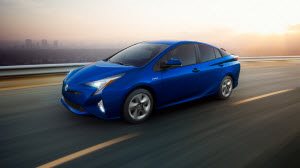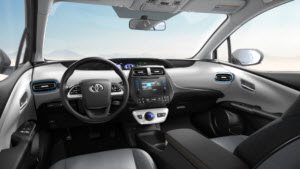Toyota Prius vs. Toyota Prius C
It isn’t always easy choosing a hybrid vehicle to help you navigate the Daytona Beach, Palm Coast, and Ormond Beach area efficiently. It’s even more difficult when you’re torn between the 2017 Toyota Prius and the 2017 Toyota Prius C. While these hybrids are very similar, there are a few differences that could help inform your decision.

In this article, we’re going to take a deeper look at these vehicles so you can learn their differences. We’ll take a look at their respective differences in performance and efficiency, interior space and comfort, and Toyota Safety Sense™. By learning more about these hybrid vehicles, you’ll be able to determine which one is right for you.
Performance & Efficiency
The 2017 Toyota Prius is outfitted with a 1.8L four-cylinder engine and the 2017 Toyota Prius C features a 1.5-L four-cylinder engine. Each vehicle comes paired with an electronically controlled continuously variable transmission (CVT), and a sealed nickel-metal hydride battery. When it comes to performance, the Toyota Prius has a hybrid net power of 121 horsepower while achieving 54/50 mpg city/highway*. The Toyota Prius C delivers 60 hybrid-net horsepower while delivering 48/43 mpg city/highway*.
Interior Space & Comfort
The Toyota Prius features a 93.1 cubic foot cabin, while the Toyota Prius C opens up with 87.4 cubic feet. Each vehicle is fit to carry five passengers on their respective cloth seating appointments. The Toyota Prius features 39.4 inches of front head room and 42.3 inches of leg room, while the Toyota Prius C features 38.6 inches of head room and 41.7 inches of leg room in the front. However, the Toyota Prius C offers more rear leg room with 35 inches compared to the 33.4 inches of rear leg room in the Toyota Prius.

Toyota Safety Sense™
 Both the Toyota Prius and the Toyota Prius C come with a bundle of driver-assisting technology features. The Toyota Prius features Toyota Safety Sense™ P, which features technology like Full-Speed Dynamic Radar Cruise Control. This system allows you to set your distance from the vehicle ahead along with your desired speed. The system will also make sure that the distance you set is maintained, even when traffic ahead slows down.
Both the Toyota Prius and the Toyota Prius C come with a bundle of driver-assisting technology features. The Toyota Prius features Toyota Safety Sense™ P, which features technology like Full-Speed Dynamic Radar Cruise Control. This system allows you to set your distance from the vehicle ahead along with your desired speed. The system will also make sure that the distance you set is maintained, even when traffic ahead slows down.
The Toyota Prius C features Toyota Safety Sense™ C, which offers a few different technologies like Pre-Collision System, Lane Departure Alert, and Auto High Beams. While this package offers a great deal, it doesn’t include the Full-Speed Dynamic Cruise Control that’s featured with the Toyota Prius. The Toyota Prius simply offers a little more in this particular category.
Toyota Prius vs. Toyota Prius C: Choosing Your Next Hybrid
We hope that our vehicle comparison of the 2017 Toyota Prius vs. Toyota Prius C was helpful in showing you how these hybrids differ. If you find that you’re still stuck with a decision to make, why not check these vehicles out up close and maybe even get behind the wheel?
Contact us at Daytona Toyota to schedule your test driver. We’re always happy to help drivers from the Daytona Beach, Palm Coast, and Ormond Beach area make the right decision.
*2017 EPA-estimated mileage. Actual mileage will vary.




